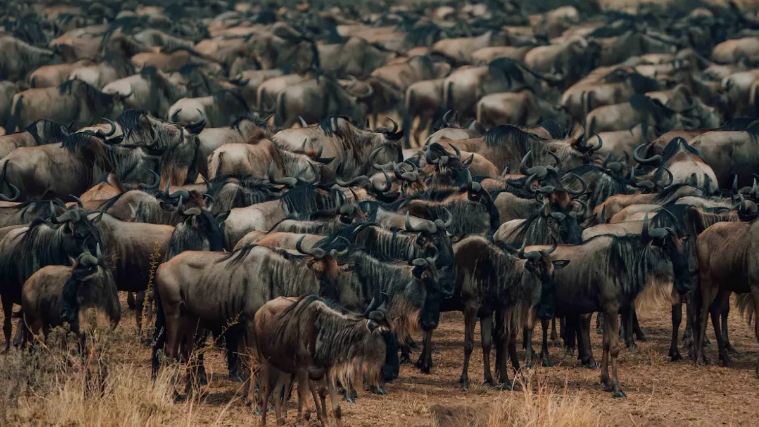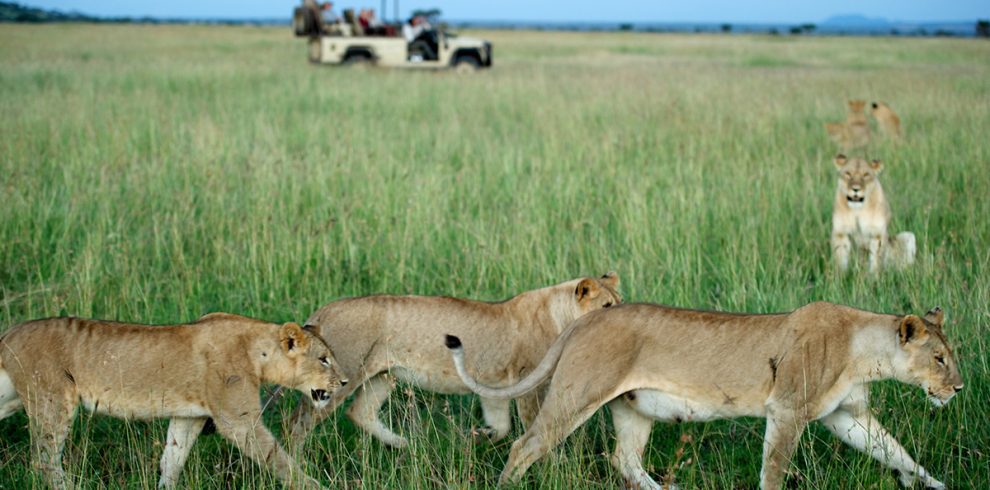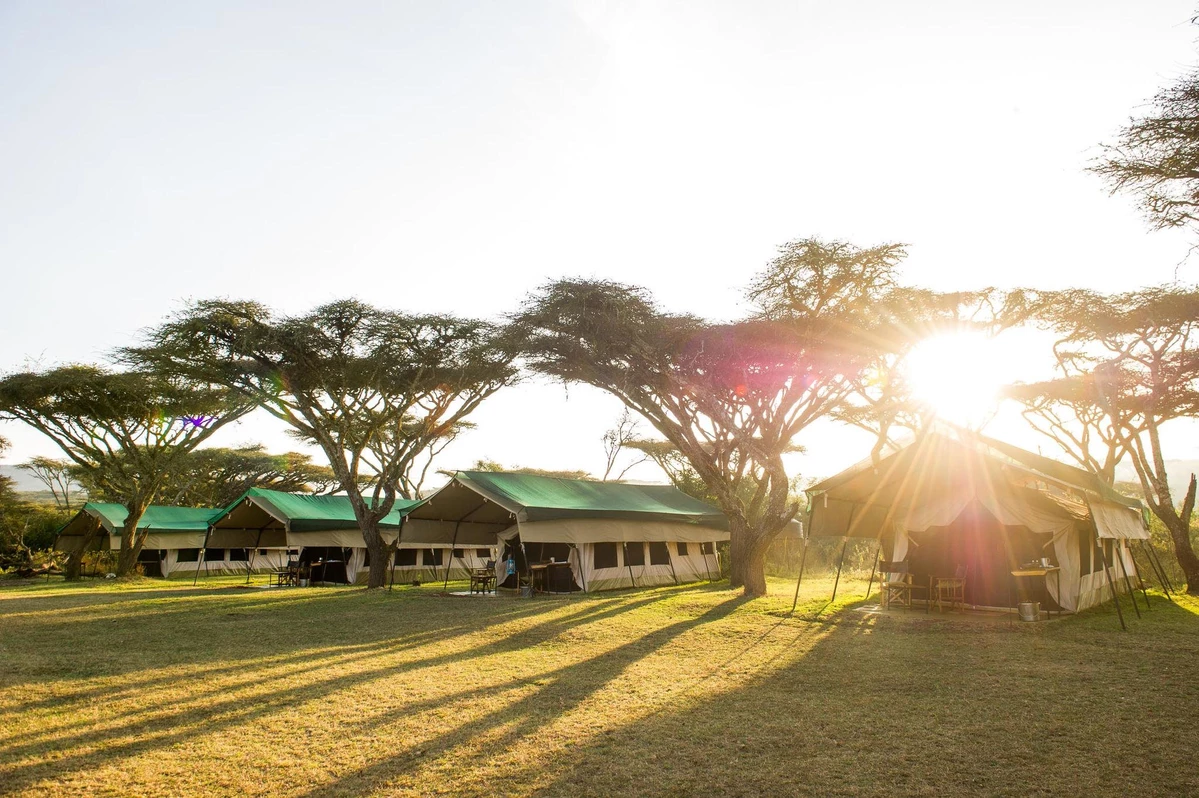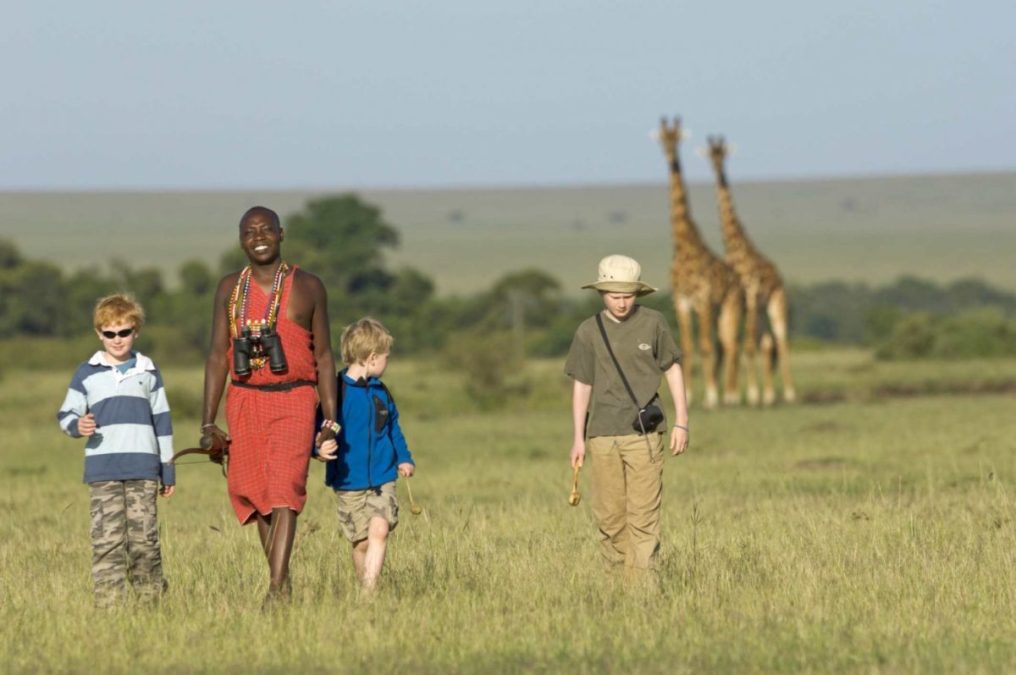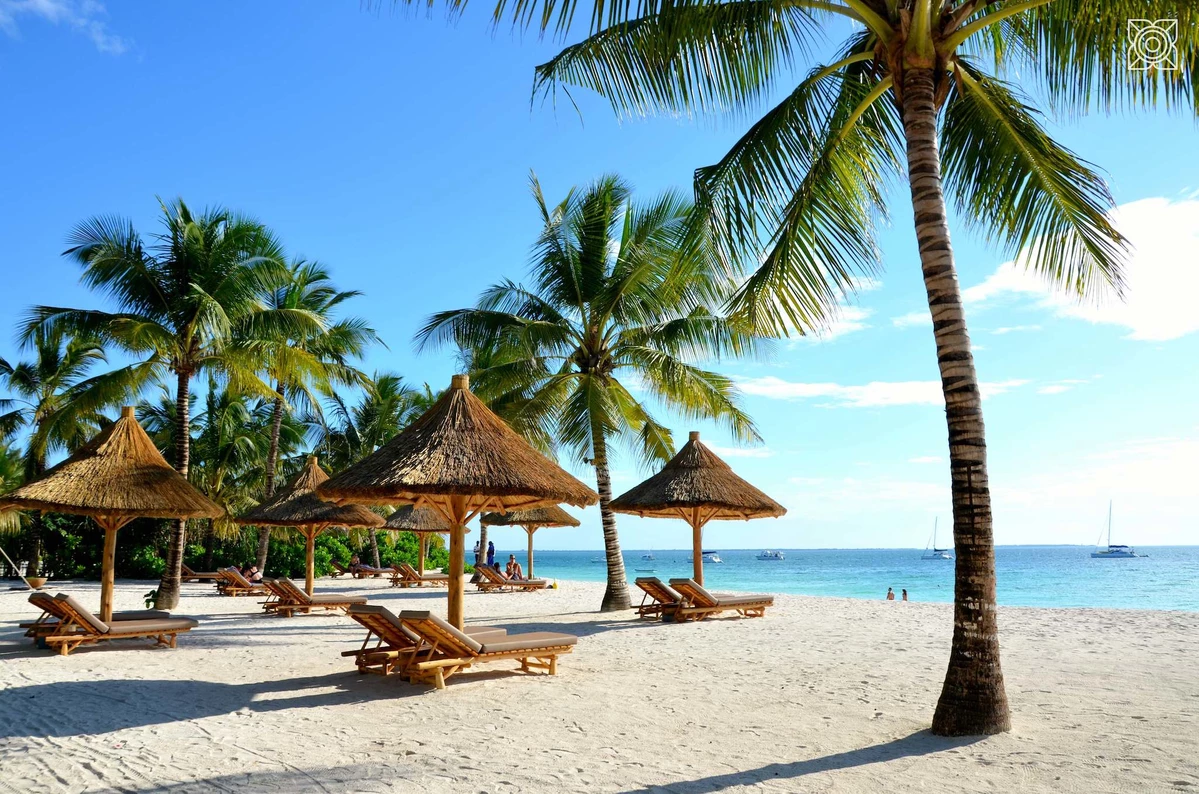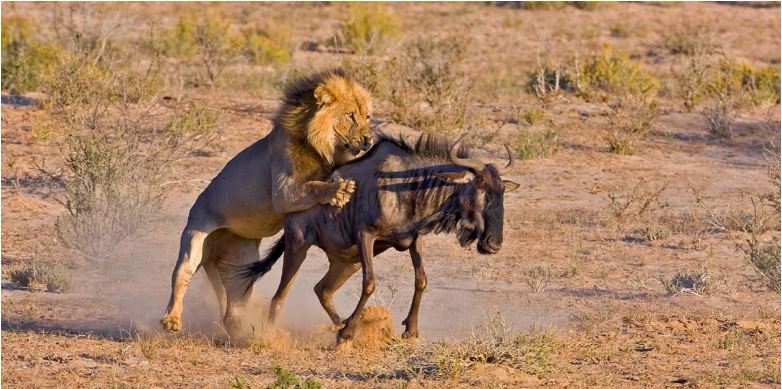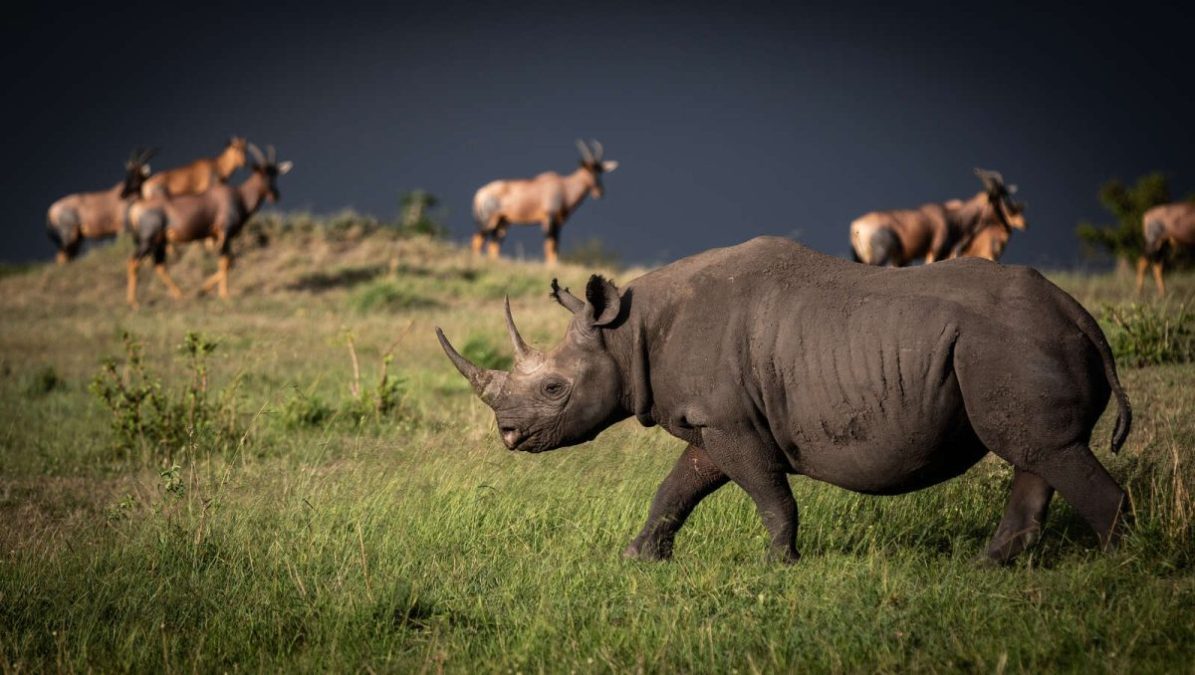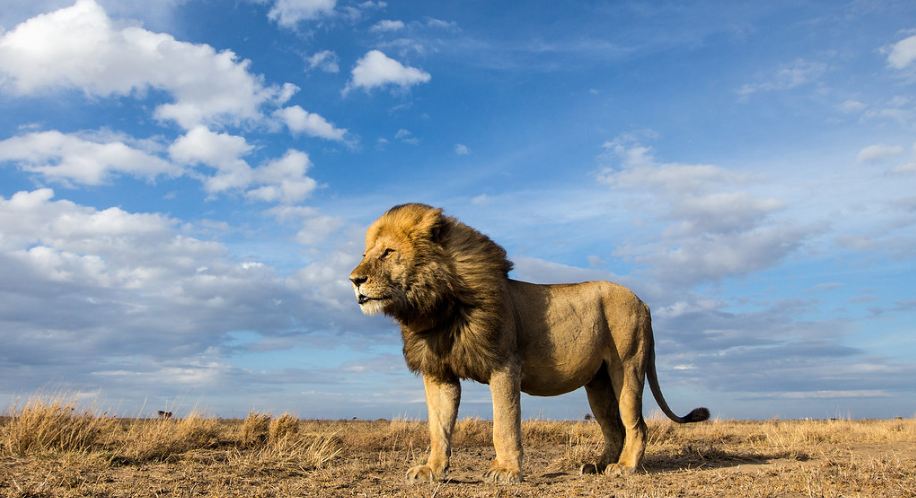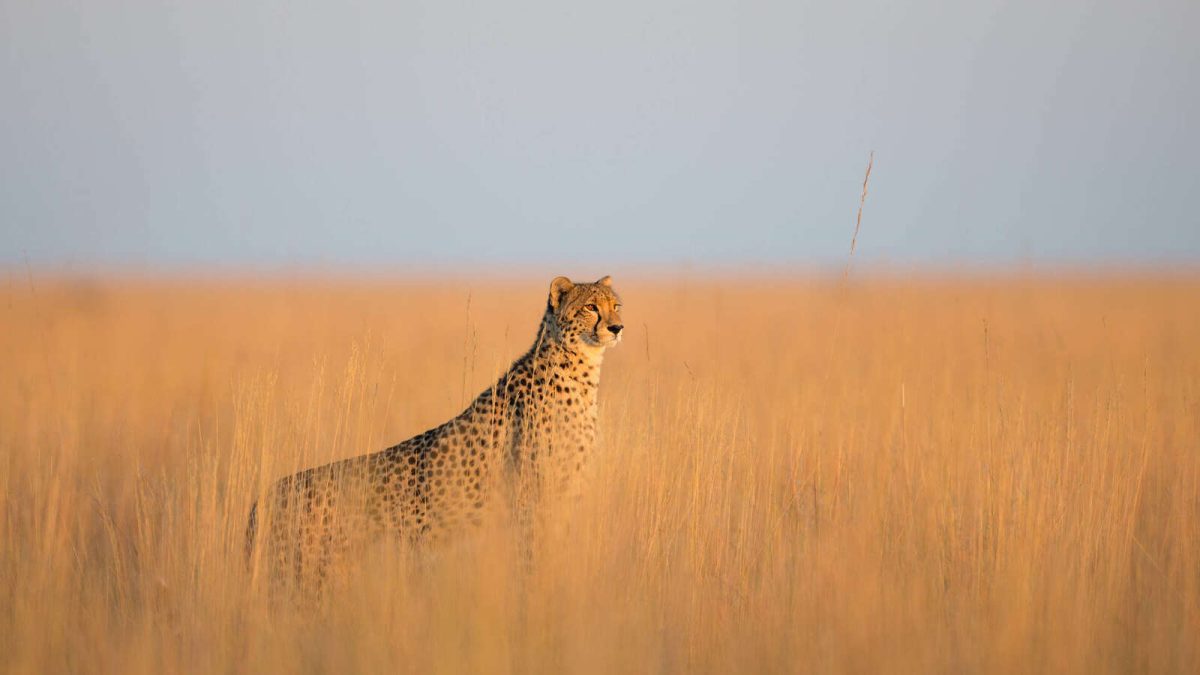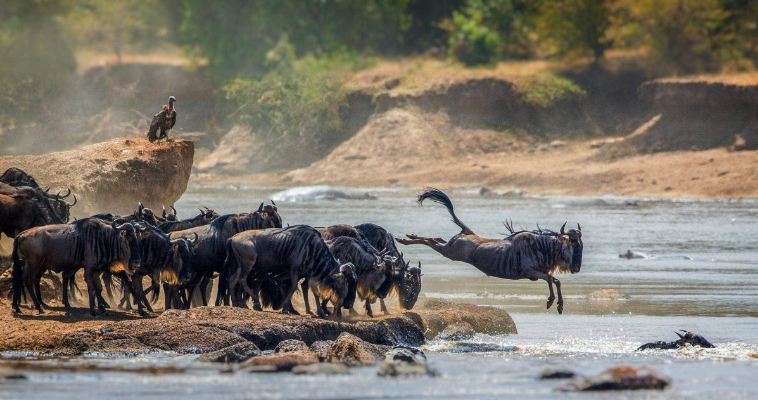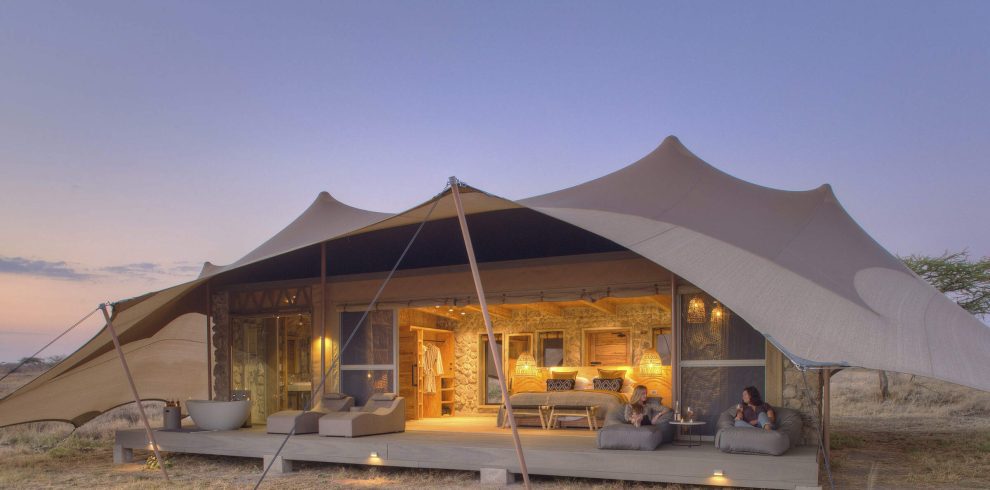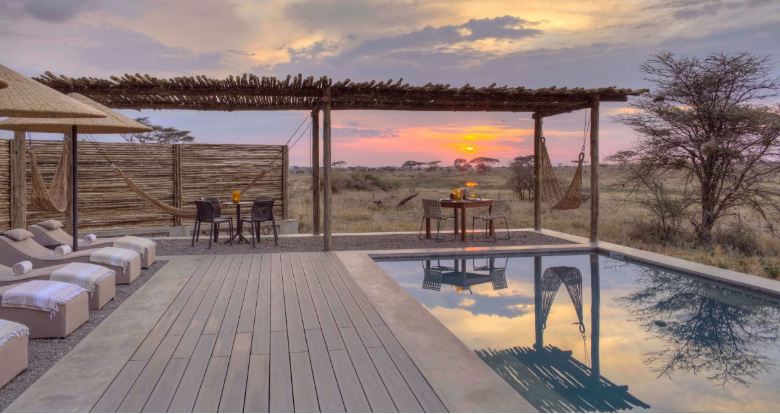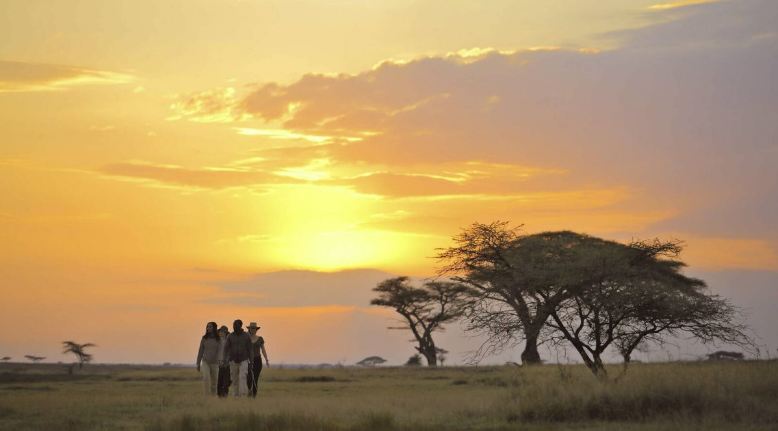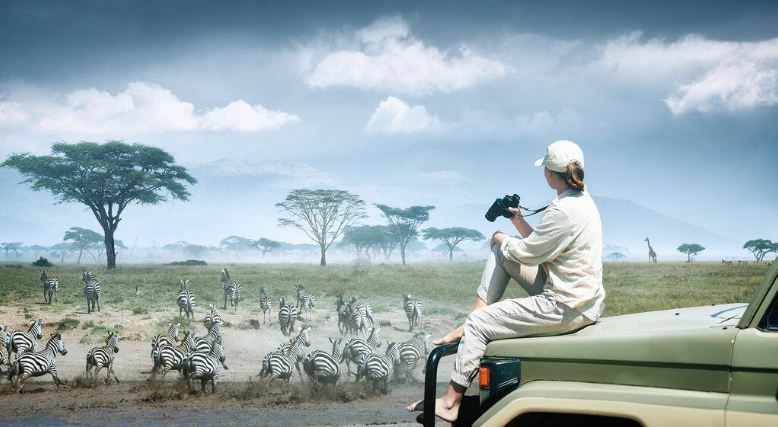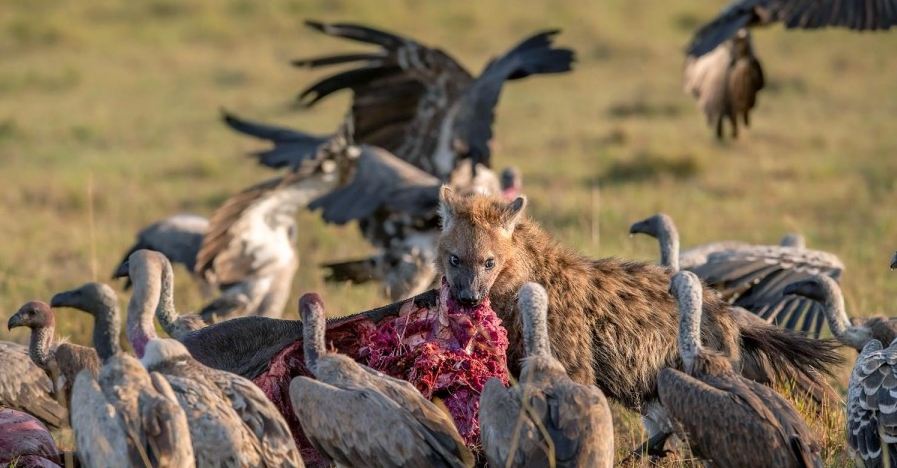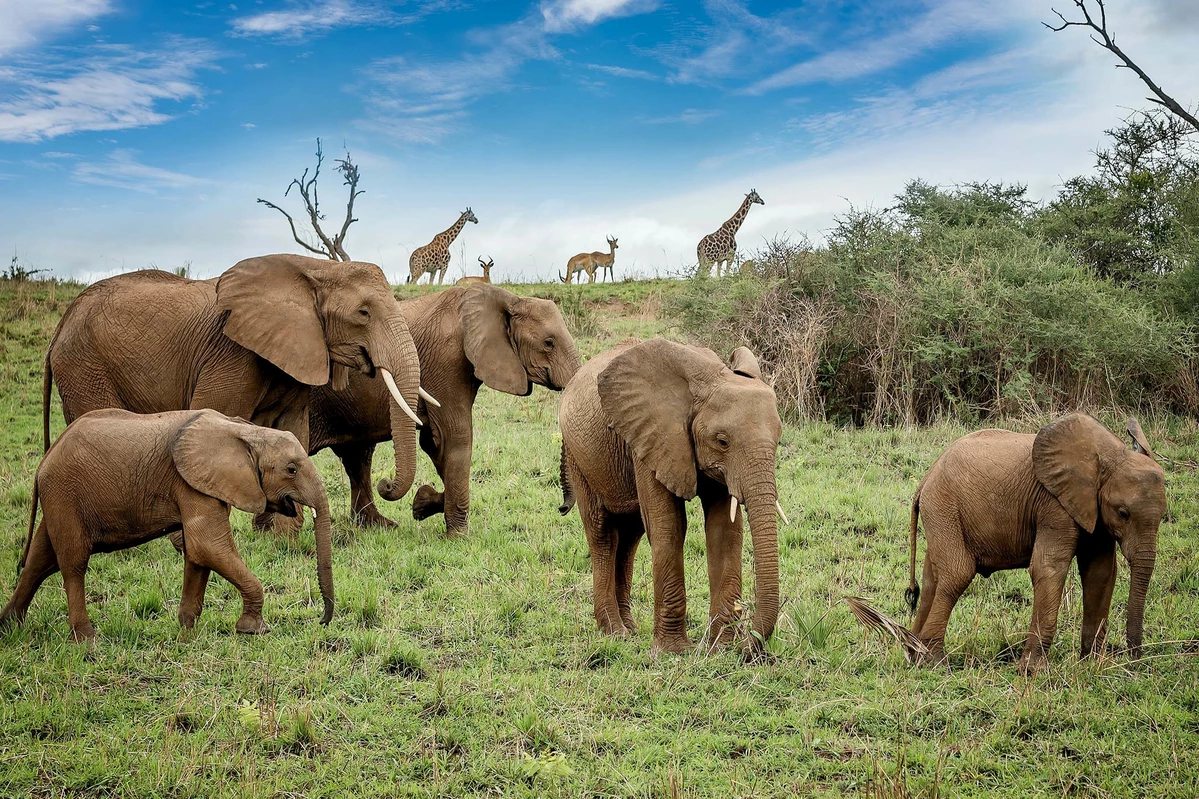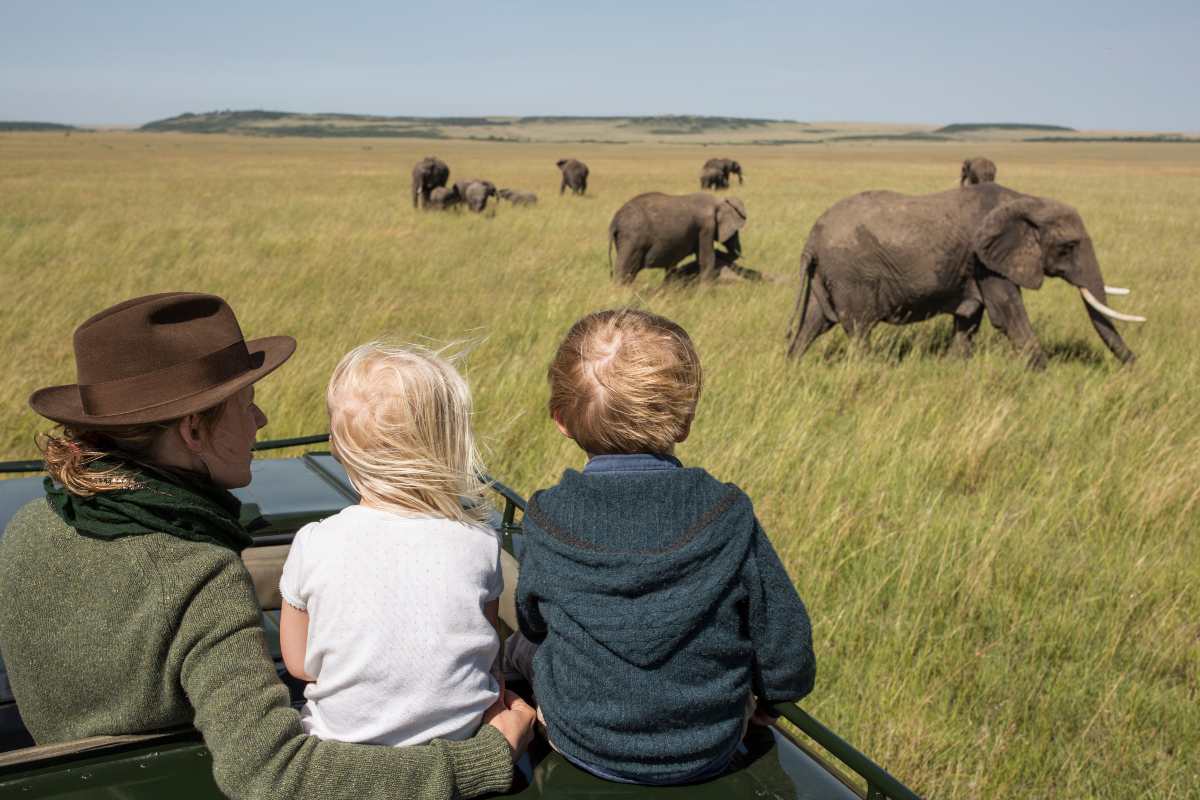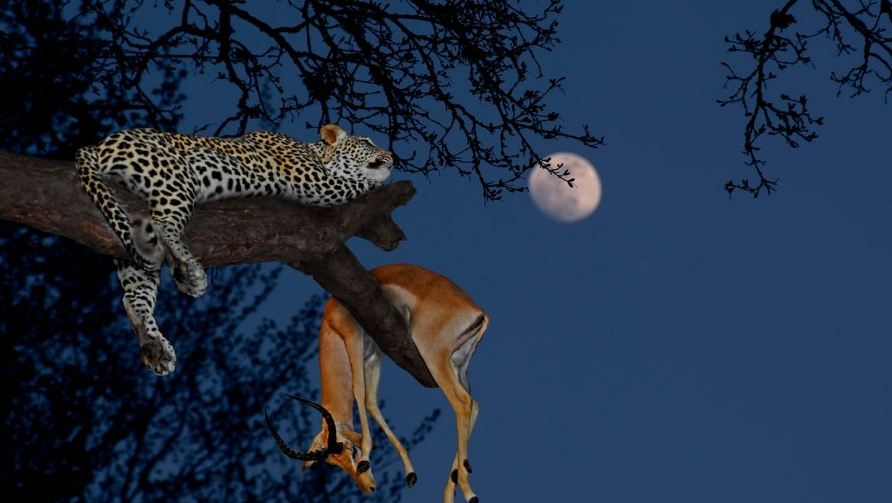Table of Contents
ToggleIf you are planning a Serengeti safari or safari to Serengeti National Park in Tanzania, you perhaps have a lot of questions.
Obviously, you want it to be the safari of a lifetime and it will be.
Why? There are only few places left on the planet with such unspoilt nature splendor, wonderful wildlife and world-class safari accommodation.
Extending over 14,763km²/5,700mi², this Tanzania safari park is a destination that fulfills your wildest dreams, time and time again.
Countless wildlife movies and documentaries have been recorded here.
This is the home of the Great Wildebeest Migration – the Greatest Wildlife Show on Earth – but the vast plains are also home to unusually dense populations of cheetahs, lions, leopards, and other predators.
We would like to share a bit more information – if only to stir the anticipation of going on a Serengeti safari – and answer the questions you might have.
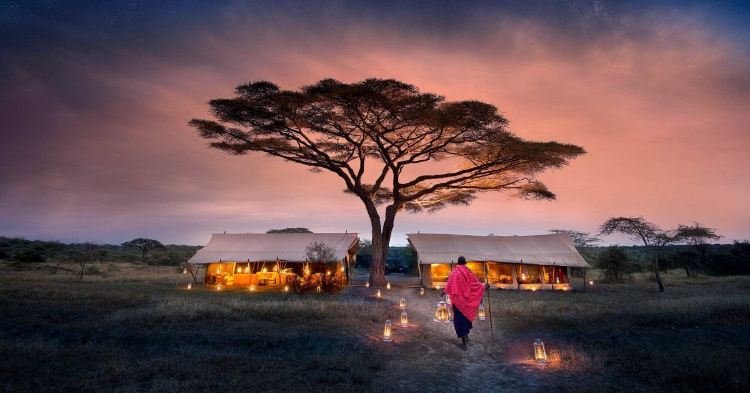
Quick Facts About Serengeti Safari
- Serengeti means “Endless Plains” or “The Land that Moves on Forever’”.
- Serengeti is home to some of the greatest concentrations of wildlife in the world.
- The bulk of the Wildebeest Migration – the largest land mammal migration on Earth takes place in the Serengeti
- One of the best places to see African lions in the wild.
- Serengeti is one of the world’s oldest, largest, and most protected ecosystems.
- High or dry season happens between July and October.
- Low or rainy seasons occurs from April to May and November to December
1. What is the Serengeti famous for?
Serengeti has become world famous for its great wildebeest migration – an iconic and dramatic scene in wildlife documentaries for decades, and a true bucket list experience.
The wildebeest migration is the largest overland mammal migration on the planet and one of the seven natural wonders of Africa.
It takes place throughout the year in the Serengeti, sharing the months of August to October with the Kenya’s Masai Mara as the herds repeatedly cross the Mara River to follow the rains and nutritious green grass.
For the rest of the year, the herds are either calving in the southern Serengeti or moving between the north and south of the ecosystem.
Serengeti is also known for hosting many large predators such as lions, leopards, cheetahs, and hyenas.
A Serengeti safari will be a highlight of a safari to Tanzania. Because it is such a bucket-list destination, many travelers choose a Serengeti safari tour to celebrate special occasions like honeymoons, engagements, and birthdays.
In addition, the Serengeti offers easy travel logistics, short transfers between camps, and English is widely spoken.
2. How Big Is Serengeti National Park?
Serengeti is so big that the original inhabitants, the Masai people, named it endless plains or a place where the land runs forever.
This expansive pristine wilderness encompasses almost 1.5 million hectares of grass plains, rocky outcrops, and leafy woodlands.
The Serengeti is nearly 10 times larger than Kenya’s Masai Mara National Reserve.
3. Where is the Serengeti Located?
Serengeti is located in the northwest of Tanzania and borders Kenya to the north.
The conservation area continues across the Kenyan border into the Masai Mara Reserve.
Serengeti National Park together with Masai Mara form the 3.2 million hectare Serengeti-Mara Ecosystem – one of the biggest, oldest, and most protected ecosystems on Earth.
4. How Long Is The Drive To Serengeti?
If you are coming directly from Arusha city, the drive to Serengeti National Park headquarters at Seronera takes around 300km.
The first half of the journey follows the same surfaced road that runs past Lake Manyara National Park to the main eastern entrance of the Ngorongoro Conservation Area.
The second takes you on a rough and dusty corrugated track around the Ngorongoro Crater rim and western plains of the NCA.
Allow at least 6 hours for the full drive, and preferably a full day. However, note that most traveller on a Serengeti safari include overnight stops at Tarangire, Lake Manyara, and or Ngorongoro Crater, which helps to break up the long trip.
5. Can I Fly To Serengeti National Park?
The fastest way to get to Serengeti is by taking a small plane from a regional airport such as Arusha Airport to one of the several small airstrips located directly inside the park.
There are several airstrips dotted around Serengeti which can also be accessed from the Masai Mara, Lake Manyara, Tarangire, or Kilimanjaro.
TIP: International flights often arrive at Kilimanjaro International Airport late at night, so we advise that you stay an overnight in at one of the lodges in Arusha city before catching a flight into the Serengeti for your Serengeti safari.
Best Serengeti Safari Areas | Where To Go
At nearly 1.5 square kilometers, Serengeti is an enormous with distinct regions that each offer a different game viewing experience.
You need to choose carefully where and when to go on a Serengeti safari, especially if you want to witness Wildebeest Migration.
1. Northern Serengeti
Northern Serengeti is a vast pristine area of wooded rolling hills, interspersed with open grassy patches and large granite outcrops known as kopjes.
It is the most remote corner of the park and most visitors on a Serengeti safari never see this region.
It is only rarely visited; far less crowded, and remains an untouched wilderness packed with stunning landscapes and abundant wildlife.
Northern Serengeti also sets the stage for the Great Wildebeest Migration’s dramatic Mara River crossings from around July/August.
During this time, huge herds wildebeest will be thundering across the crocodile-infested Mara River.
It is a perfect place to go on a hot-air balloon safari in Serengeti for a bird’s eye view over hundreds of thousands of wildebeest, and a good area to see African elephants and giraffes.
Tip: While Serengeti has all African Big 5 animals – rhino sightings are rare. Your best bet to see these iconic animals on a Serengeti safari is in this northern region of the park.
2. Southern Serengeti
This most accessible area of the park. And it can get a little busy during the high Serengeti safari season from around June to October.
During the rainy season (about January to March), hundreds of thousands of wildebeest, zebra, and gazelle graze here on fresh green grass.
It is also the time that the main calving season takes place and predators – especially lions, leopards, and cheetahs – are taking every opportunity to hunt easy prey.
Southern Serengeti is also within driving distance of the Ngorongoro. This makes it easy to combine your Serengeti safari with a visit to the Ngorongoro Crater.
The Ngorongoro Crater offers some of the easiest Big 5 viewing in Africa.
The ancient Olduvai Gorge is also situated near the Southern Serengeti plains. Here, you can learn about archaeology, history, and our ancient hominid ancestors.
Its chief claim to fame is the rich treasure trove of human and animal fossils that it has yielded.
Few places in the world can match this area’s long human history and this fact has earned this part of Africa the title ‘Cradle of Mankind’.
3. Central Serengeti
This area is the busiest part of the park – especially during peak Serengeti safari season.
It encompasses the world-famous Seronera Valley.
The picture-perfect landscape of this pristine valley is characterized by endless savannas that stretch beyond the horizon.
During the northward and southward migrations, Seronera plays host to the greatest wildlife show on earth as over a million wildebeest and zebra pour through the valley in a thunder of echoing hooves.
However, the true beauty of Seronera is that no matter what time of year you might come here, a whole world of life, drama, action, and wonder awaits!
The secret is out – there is simply no better place in Africa to observe the large carnivores in action!
It is not unusual to encounter all four African large predators (lion, hyena, leopard, and cheetah) during the course of a day along with a multitude of smaller predators (mongoose, jackal, serval, and bat-eared fox).
Seronera is actually derived from the Maasai word ‘siron’ meaning the place of the bat-eared fox.
4. Eastern Serengeti
The eastern Serengeti offers diverse habitats, a wide range of wildlife, and good grazing for the migrating wildebeest between December and March.
It’s a popular pit stop during the Migration’s calving season (between February and March), which attracts many large predators.
This area is much quieter than the rest of the Serengeti and is a great location to avoid tourist crowds.
It’s also an excellent area to see big cats – one of the best for cheetahs – and delivers those iconic lions-lazing-on-kopjes scenes.
The eastern plains are also home to the largest concentrations of hyenas during the green season.
Large clans of hyenas numbering up to 30 individuals are regularly spotted here.
Hyenas are the most abundant predator in the entire ecosystem.
4. Western Serengeti
The Serengeti’s Western Corridor is a special place that is seldom explored by those on a Serengeti safari. The corridor stretches west from Seronera to almost Lake Victoria.
It features dense stands of acacia trees interspersed with broken woodlands and open plains.
The dominant feature is the Grumeti River, which runs almost the entire length of the corridor. The river is a sanctuary for huge Nile crocodiles and hippos.
Every year between around mid-May and July, enormous herds of wildebeest (around 40km long) arrive on the banks of the Grumeti to kick off the main event: the treacherous river crossings.
This is one of nature’s most thrilling spectacles to witness, yet a bittersweet experience as many of the wildebeest are killed by hungry crocodiles.
The Grumeti River also supports a unique riverine forest, which is home to the beautiful black and white colobus monkey.
And if you’re looking for a classic big game safari combined with away-from-the-crowds luxury accommodation, then we recommend the privately owned Singita Grumeti Reserve.
Different Accommodation Types On A Serengeti safari
1. Basic Camping
If you are a budget traveler, the cheapest option is a basic camping safari with a budget operator.
2. Hotel in the Bush Lodges
Serengeti is also serviced by several ‘hotel in the bush’ lodges operated by chains such as Sopa and Serena.
These tend to be upper mid-range in price accommodation and offer high levels of comfort.
They also tend to be designed to close out the bush at night, making them well suited to first-time African safari-goers nervous about wildlife encounters.
3. Small Lodges and Tented Safari Camps
The park is also serviced by innumerable small lodges and tented safari camps (some permanent, others seasonal in order to follow the migration).
These combine a medium to a high level of comfort with a genuine bush atmosphere.
There is also a high probability of wildlife passing through, especially during the night.
Generally, these camps have prices that reflect the level of exclusivity and luxury they offer.
Note: Whichever option you choose, practically all Serengeti safari prices are all-inclusive and incorporate transport, park fees, game drives, accommodation, and meals.
Recommended lodges or camps On a Serengeti safari
If your safari budget runs to it, there are some superb exclusive small lodges and tented safari camps scattered around Serengeti National Park.
We tend to favor places with a more remote crowd-beating location.
- Sanctuary Kusini Camp, set among massive boulders in the far south, offers superb wildlife viewing during February and March
- The semi-permanent Dunia Camp near Moru Koppies offers excellent wildlife viewing all year, peaking from December to March
- The super-stylish &Beyond Grumeti Serengeti Tented Camp is easily the pick of the lodges in the western corridor, where wildlife activity peaks from May to July
- And there’s not much to separate Lamai Serengeti and Sayari Camp, which are the two most exclusive properties in the far north, and ideally placed to catch wildebeest river crossings from August to October.
Of the more mid-range options, Ndutu Safari Lodge which is located near seasonal Lake Ndutu is a great value and offers superb predator viewing from December to April.
What About Mobile Camping In Serengeti?
Mobile Serengeti safari camps are lavish tented affairs with all the creature comforts of a lodge and the added advantage of moving with the seasonal Wildebeest Migration.
If your dream Great Wildebeest Migration Safari is a contemporary take on the expeditions of early explorers and to stay as close to the herds as possible, then consider a mobile safari – an authentic experience in exclusive wilderness areas.
You follow in the tracks of huge herds of wildebeest as they cross the vast Serengeti plains.
Here are some of our favorite mobile safari camps in Serengeti:
- Olakira Migration Camp
- Serengeti Kati Kati Camp
- Sanctuary Kichakani Serengeti Camp
When to Go: Best Time of the Year for a Serengeti Safari
The Serengeti’s density of wildlife offers a spectacular safari experience no matter what time of the year you visit.
Although some of the wildebeest migrate to fresh grazing, not all of them do – and none of the predators move with the herds either.
The park’s wide-open plains and mild climate mean that vegetation is never too thick to see wildlife, and the region’s two rainy seasons (November to December and April to May) are seldom too inclement.
Short thunderstorms mostly occur in the late afternoons, but the animals won’t relocate when it’s raining. Read more about the best time to visit Serengeti.
Guidelines for Seeing the Great Wildebeest Migration on A Serengeti Safari
For many travelers, the question of exactly when to go on a safari in Serengeti really depends on whether or not you want to witness the Great Wildebeest Migration.
However, this natural event, a free-flowing phenomenon, and its exact timing cannot be foreseen.
It depends on the annual rainfall patterns and essentially, the wildebeest themselves.
| Approximate Time | Region | |
|---|---|---|
| Calving (Birthing) Season | February to March | Southern Serengeti |
| Intense Predator Action | February to March | Southern Serengeti |
| Rutting (Mating) Season | April to May | Western & Central Serengeti |
| Grumeti River Crossings | May to June | Central Serengeti |
| Mara River Crossings | July to August | Northern Serenegti |
| On the Move | October to January | Northern to Southern Serengeti |
Please Note: The above are estimated dates and places.
The Great Wildebeest Migration is a year-round, circular journey. And the dramatic river crossings cannot be predicted.
It generally occurs from around May to September. Your best chance to see a river crossing may require spending many days at a site where the wildebeest have congregated.
Cost of Serengeti safari
Before we look at the approximate costs of a safari in Serengeti National Park, it’s important to consider these budget-influencing factors:
- Your preferred level of comfort.
- The time of year you want to go for a Serengeti safari.
- Flying or driving between safari camps and lodges. Flying is more expensive for travelers but offers you more time on a Serengeti safari. Driving allows you to establish a good rapport with one driver-guide throughout your safari trip.
- Extra Serengeti safari activities you want to add to your itinerary, such as guided walks, hot-air balloon rides, spa treatments, and cultural village tours.
Guidelines for Serengeti Safari Budgets
4-Star Comfort
- Low Season: $500 – $675
- High Season: $550 – $725
4-Star Luxury
- Low Season: $800 – $1,200
- High Season: $950 – $1,350
5-Star Luxury
- Low Season: $1,250
- High Season: $1,850
We take pride in tailor-making our Tanzania Serengeti safari itineraries that make sense for your budget and personal travel interests.
We don’t offer one-size-fits-all safari tour packages.
We prefer to create a customized journey that satisfies your individual needs. Please contact us to help you plan a Serengeti safari itinerary:
A Serengeti Safari Combines Best With…
The Rest of Tanzania
- Best place in Tanzania to see the Big 5
- Incredible cliff-top lodges
- See huge numbers of elephants, buffalo, and giraffes (June to October)
- Fantastic bird watching – over 550 species
- Boat safaris
- Excellent bird watching, especially flamingos
- Spot tree-climbing lions
- Climbing Africa’s tallest mountain
Arusha National Park
- The most accessible safari park on the Tanzania Northern Safari circuit
- Perfect for a bush-to-beach finale
- Luxury resorts on gorgeous beaches
The Rest of East Africa
- See the Wildebeest Migration in the Masai Mara
- Encounter massive elephant herds in Amboseli
- Discover hidden gems like Lewa and Laikipia
- Africa’s most accessible gorilla trekking destination
- Amazing Big 5 safari in Akagera National Park
- Home to half of the world’s mountain gorillas
- The most affordable and safe gorilla trekking destination in Africa
- The best place to see wild chimpanzees in Africa
- One of Africa’s most attractive birding destination
- One of the only two places in Africa where you can see the Big Five animals, gorillas, and Chimpanzees in their natural habitat.
Our Favourite Serengeti Safari Itineraries
The Serengeti is a bucket-list destination for many visitors to East Africa and the Great Wildebeest Migration is a must-witness event for any wildlife enthusiast.
Whether you’re a first-time visitor or a seasoned safari-goer, Serengeti’s offering is so diverse that you’ll always discover something new – no matter how many times you’ve been there.
Tips for Planning Your Serengeti Safari
- Visit at the right time: if you want to encounter the dramatic Wildebeest and Zebra river crossings, make sure your Serengeti safari itinerary matches the movement of the herds.
- Book well in advance: well-located tented safari camps at the Migration’s hot spots get booked out early – often a year in advance.
- Choose your Serengeti safari activities: morning and afternoon game drives are standard activities. But some lodges also offer hot-air balloon safari tours. Activities, like guided bush walks and night drives, are only permitted in some areas.
- Expect crowds in high season: many parts of the Serengeti National Park are mostly quiet throughout the year. But the Migration’s big events like the Grumeti River and Mara River crossings attract many visitors between around June and September.
- If you prefer being away from the crowds, consider visiting during the low season for great game viewing and seeing the Migration’s herds on the plains. Alternatively, you opt for a camp in a more private area of the Serengeti National Park.
Ready to Start Planning Your Serengeti Safari?
You have set your travel goals, made your Serengeti safari wish list, and worked out your budget range and preferred dates.
It’s time to chat with our safari expert to start planning the Serengeti National Park safari holiday of a lifetime:

